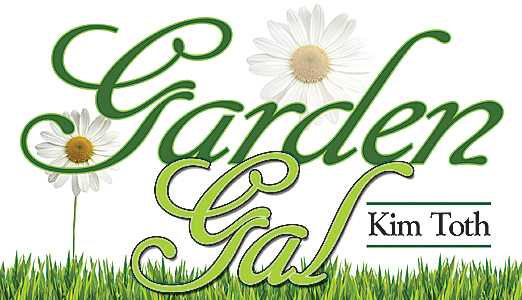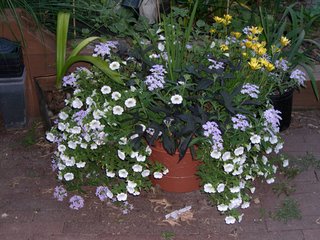I have a shade garden across the far side of my backyard. The eastern half gets virtually no sun, just a little in the morning, and the western side gets about 2 hours of afternoon sun. So throughout these gardens I have Hostas, daylillies, bleeding hearts, irises, hydrangea, astibles, and every variety of coral bells I could find. That’s a LOT of green!
Sure, most of these things flower at some time during gardening season, but there’s still a lot of green foliage in between. So I wanted to jazz things up a bit.
Every year I get plenty of coleus to add color. I love coleus, but it’s only an annual in these parts. (I’ll get more into coleus on another date.) So I specifically looked for some perennials with variegated foliage and interesting colors to provide some contrast. Here’s what I found:
A light green and white leaf Calamint (pictured above). Specifically called Calamintha grandiflora “variegata,” it is a close cousin to the garden mint, but without the nasty spreading habit. This selection forms an upright, bushy mound of soft green leaves, splashed with creamy white. Pleasantly fragrant, its rosy-pink flowers are studded on short spikes among the leaves in mid summer. This will slowly spread to form a small patch. It is useful towards the front of the border (which is where I put it), or in a woodland setting among Hosta or ferns (perfect!). It’s also attractive to butterflies.
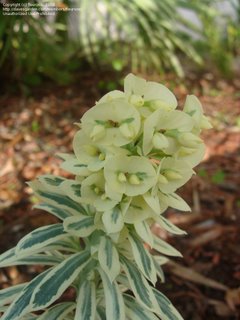 Next up is something called the Tasmanian Tiger or Spurge. A spectacular plant selected for its uniformly colored variegated foliage — leaves are grayish-green with clear white margins. Tall pale green stems support cream-white flowers with green bow-tie centers. It’s dependable color and texture looks great all season. A vigorous grower that tolerates heat and drought, it’s excellent for use in difficult spots where nothing else grows.
Next up is something called the Tasmanian Tiger or Spurge. A spectacular plant selected for its uniformly colored variegated foliage — leaves are grayish-green with clear white margins. Tall pale green stems support cream-white flowers with green bow-tie centers. It’s dependable color and texture looks great all season. A vigorous grower that tolerates heat and drought, it’s excellent for use in difficult spots where nothing else grows.I also chose a flowering ground cover called Lithodora. Lithodora diffusa (specifically) is a hardy evergreen creeping ground cover originating in southern Europe and requiring only a little attention (Yay!). It can hug the ground very closely or mount upward to six inches or rarely as high as a foot. It spreads as a dark green mat that produces its first few brigh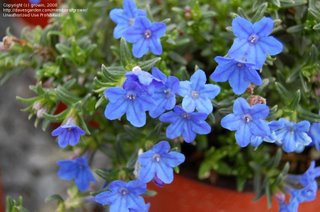 t azure blue flowers as early as March, but is really going to town blooming in May & June, continuing to bloom at intervals & less overtly up to Autumn's first frost. Check out that color!! Too cool, I had to have it!
t azure blue flowers as early as March, but is really going to town blooming in May & June, continuing to bloom at intervals & less overtly up to Autumn's first frost. Check out that color!! Too cool, I had to have it! Today we are getting some needed rain (Yes! I don’t have to water tonight), but Saturday and Sunday will be optimal for gardening, or ponding, which is what I’ll be doing.
My pond’s in need of great attention. I’ve been cleaning the filter daily and it’s time to vacuum out the sludge in the bottom. We’ll also be installing (or trying to install) a new waterfall this weekend. I’ll let you know how it goes.
And by the way, the “pregnant” fish – is still pregnant and hugging the bottom of the pond. I hope she lays those eggs soon, we’re referring to her as Brangelina at the moment …
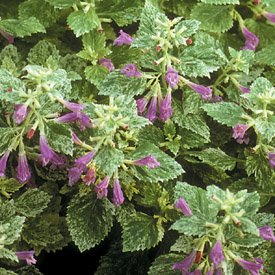 I really stocked up on perennials this year. So much so, that I think I’ve just about cut my annual purchases in half. Here’s a few more new ones I want to share with you.
I really stocked up on perennials this year. So much so, that I think I’ve just about cut my annual purchases in half. Here’s a few more new ones I want to share with you.  Next up is something called the Tasmanian Tiger or Spurge. A spectacular plant selected for its uniformly colored variegated foliage — leaves are grayish-green with clear white margins. Tall pale green stems support cream-white flowers with green bow-tie centers. It’s dependable color and texture looks great all season. A vigorous grower that tolerates heat and drought, it’s excellent for use in difficult spots where nothing else grows.
Next up is something called the Tasmanian Tiger or Spurge. A spectacular plant selected for its uniformly colored variegated foliage — leaves are grayish-green with clear white margins. Tall pale green stems support cream-white flowers with green bow-tie centers. It’s dependable color and texture looks great all season. A vigorous grower that tolerates heat and drought, it’s excellent for use in difficult spots where nothing else grows. t azure blue flowers as early as March, but is really going to town blooming in May & June, continuing to bloom at intervals & less overtly up to Autumn's first frost. Check out that color!! Too cool, I had to have it!
t azure blue flowers as early as March, but is really going to town blooming in May & June, continuing to bloom at intervals & less overtly up to Autumn's first frost. Check out that color!! Too cool, I had to have it! RSS
RSS
